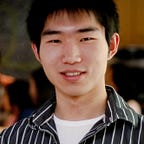My son helps me to notice an unconscious egocentric bias and to become better at work
One day, I opened a new toy for my soon-to-be-3-year-old son. It was a ready-to-assemble airplane: with available tools like a screwdriver, bolts, and nuts. Once kids install the wings and propeller, by themselves, they can make it an airplane!
It was (guilty) fun to watch how my son started the “installation” and tried to spin the screwdrivers around randomly to install the wings. After a short time, he turned over for help: obviously it didn’t work and he started realizing that!
“Rotate it clockwise, then it can be firmed” — I said, with my hand acting as if the screwdriver’s turn clockwise to show how it works.
My son looked at me, confused. I know it’s hard for a kid at this age to know how things work in their first impression, so I repeated “Rotate to its right, like how the clock goes, clockwise. Try it.” and continuously spinning my hands clockwise as a demonstration.
I saw a 100% “what are you talking about?” face, but he slowly started turning the screwdrivers, purely mimicking my hand gesture, and found the surprising fact that it worked! Now he was jubilant and hurried back to the journey to build the airplane.
Problem solved! While something bothered me: why still the “what are you talking about?” face? It is definitely not “I got it, let me try …” face. Anyway, it’s hard to know a 3-year old kid’s inner mind, so just let it be.
The clock
At dinner time, while we were baking pizza, my son ran to the kitchen area, and pointed to the oven’s digital temperature meter, shouted, “Clock!”. I was confused: “Wait, this is not a clock, this is an oven”. My son walked away, with the same “confusing” face. What was going on?
While eating pizza together, I suddenly realized the connection between the two things, and something struck me: the clock may mean totally different things for me and my son.
- From my perspective, the impression of a clock is definitely analog, with three hands all go “clockwise”. This is so nature: my parent’s clock at home had three hands, my elementary/middle/high school’s clocks were all analog, with three walking hands; and there is even a brain teaser like “when do the hour and minute hands overlap, during 9–10 AM?”
- From my son’s perspective, the clock is definitely digital, with four numbers. This is the clock he sees every day: the clock App to wake him up in the morning at “08:00”, my watch’s digital face to show it’s time to go home around “18:20”. How could four numbers spin as if the screwdrivers, that would be insane!
To test out this hypothesis, I dig out my old watch: it has three hands with the seconds-hand moving “clockwise”, and showed my son how the “clock” goes “clockwise”. Looking at his “woo! this is the clock” face, I knew the mystery is solved :)
My learnings
My son and I grew up in different environments, which leads to two different “clocks”. If we look around in your office, it is very common for others to have different “clocks” viewpoints, however, this fact can be easily neglected. For fellow data scientists, here are two situations you may find familiar:
- Sometimes we know the “analog clock” but others are familiar with the “digital” one. It is uncommon to see a Data Scientist comfortably use a q-q plot, along with skewness and kurtosis to explain the “exciting finding” to the product team, leaving the room temperature to absolute zero degree and all plain faces. Regardless of how great that idea might be, you will (almost) never get a buy-in from the other party. In this case, you need to know their “digital clocks” to convey the story from a product perspective.
- In other times, we may only know the “digital clock” and have little knowledge about “analog clock”. Remember the first time you ask a Spark Engineer why your Spark SQL query is so slow? The reasons are: “the join key is skewed”, “one node is overloaded with data”, hence “you need to find one way to avoid the skewness”. Now, do you feel, in their world, the “digital number” can spin? At this time, it is better to learn their language and find what’s the reason they explain things differently than your knowledge scope. Try to learn their “analog clock”. If you find learning the “analog clock” is too far-reaching, don’t worry! Just like what my son did, show them the “clock” you know, and ask for an alternative explanation. Remember, this is not naive, this is bravery.
So this is the lesson I learned from my son. And now, what’s the clock you know?
